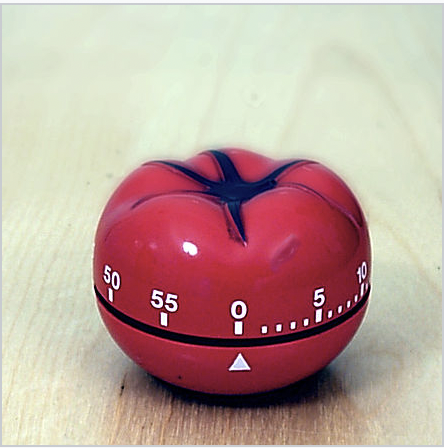Pomodoro technique
Wondering the effective way to study?
Check this Pomodoro technique.
What is Pomodoro Technique?
First, pomodoro is tomato in Italian.
So, study in tomatoes rather than other techniques. (?)
I did not quite get why Francesco Cirillo give it that name in 1980s.
Turned out that he happened to use this tomato-shaped timer in his kitchen at the first time he tried this technique. And he wrote 130-page book about it. What??

The Pomodoro Technique is a time management technique that encourages people to work at fixed time intervals typically 25 minutes and followed by short breaks typically 5 minutes. By doing a such technique, we can maintain our concentration as well as stave off mental fatigue.
Steps
The original technique has six steps:
- Decide on the task to be done.
- Set the Pomodoro timer (typically for 25 minutes).
- Work on the task.
- End work when the timer rings and take a short break (typically 5–10 minutes).
- If you have finished fewer than three Pomodoros, go back to Step 2 and repeat until you go through all three Pomodoros.
- After three Pomodoros are done, take the fourth Pomodoro and then take a long break (typically 20 to 30 minutes). Once the long break is finished, return to step 2.
Is it scientifically proven?
The perception of time
Henri Bergson, philosopher, and Nobel prize in literature in 1927, explained about various aspects of time. He found that only one of them produces anxiety: It's a dimensional aspect that makes us want to always measure it and triggers the idea of being late, run out of time. However, seeing time as a series of events such as: waking up, taking a bath, eating breakfast, go to school-- does not trigger anxiety.
The Pomodoro technique might encourage us to think about our tasks as only sequences of time intervals need to be spent. We see the 25 minutes time interval as a vehicle to achieve something rather than as something we have to reach for. Reducing mental anxiety so that we can achieve a greater level of concentration.
The breaks that brain needed
A study published in the journal Cognition concludes short breaks help keep your attention span on track. The study lead and psychology professor at the University of Illinois, Alejandro Lleras explained that the mind tunes out after working consistently on one project. In his words, “When faced with long tasks such as studying before a final exam, it is best to impose brief breaks on yourself. Brief mental breaks will actually help you stay focused on your task!”
Kill the boredom before it kills you
Working for long hours on a task can trigger cognitive boredom. Research confirms that such weariness encourages an unengaged mind. Put simply, cognitive boredom takes a toll on your focus but following a work-break-work pattern such as the Pomodoro Technique can solve this issue.
There's even evidence that the phrase "bored to death" has some truth to it. As part of the Whitehall II Study, begun in 1985, British civil servants answered questions about social determinants of health, including some questions about boredom. More than two decades later, Annie Britton, PhD, and Martin Shipley, PhD, compared their responses with death records. They found the people who reported experiencing a great deal of boredom were more likely to die young than those who were more engaged with the world (International Journal of Epidemiology, 2010).
Other scientific proofs?
I am still wondering about the scientific evidence behind the interval length, break length, how the brain absorb knowledge, etc. Need more literature research.
Practical use
There are apps to make our life easier rather than setting the timer manually.
If you have an iPhone, try Focus Keeper. Meanwhile, Android users can check out Pomodoro Timer Lite.
Linked notes
015_Notes_Productivity
maybe good for 001_PJ_home_Youtube